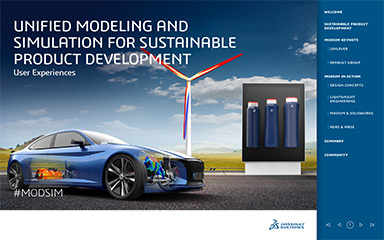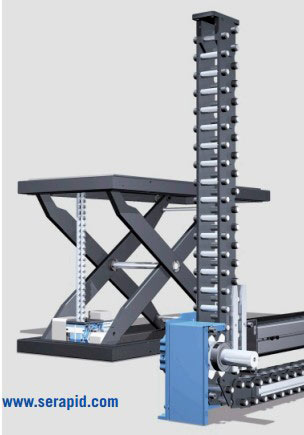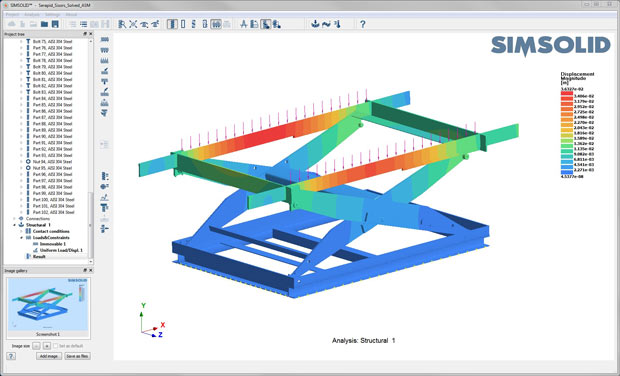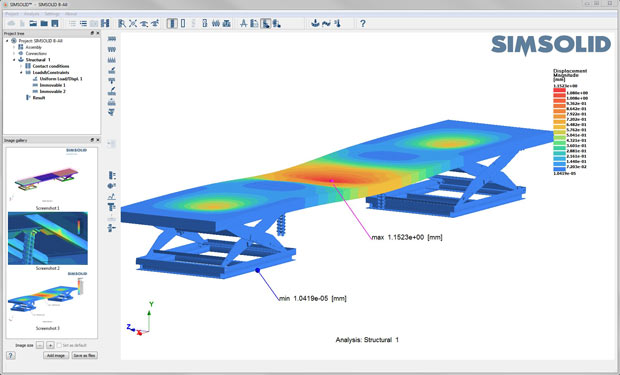
Scissor lift analyzed with SIMSOLID. Image courtesy of Serapid.
Latest News
February 29, 2016
Serapid designs, manufactures and installs systems for transfer of heavy loads based on its unique “rigid chain” technology. Essentially a chain that can push, the technology consists of interlocking links that behave like a chain yet lock like a rigid bar, providing a telescopic actuation mechanism that is environmentally friendly and works in harsh environments. Serapid’s custom solutions range from individual components to turnkey stage systems, and encompass a variety of applications in industries as diverse as architecture, nuclear, medical technology, defense, automation, quick die change, engineering, manufacturing, theater and entertainment.
Bob Adams, engineering manager at Serapid, reports that he and his team just completed a successful evaluation and initial set of design studies using SIMSOLID, a new structural simulation tool that works directly on imported CAD geometry, eliminating the two most time-consuming and labor-intensive aspects of structural analysis: CAD geometry simplification and mesh preparation. As a result, Serapid is now in the process of implementing SIMSOLID to expand its use of simulation across all its product lines.
SIMSOLID was first brought to Adams’ attention by Gennadiy Evenchik, a Serapid design engineer who specializes in its theater lifting systems and was the firm’s most intensive user of its existing structural analysis tool, SOLIDWORKS Simulation. “I was really a bit of a hard sell” on SIMSOLID, says Adams. “I’ve taken graduate courses in finite element analysis (FEA) – I’ve done the math the hard way. I know what makes a good finite element model; I know what makes a bad finite element model. That is the thing I’ve been working with internally, trying to teach my guys how to constrain a model, because if you have bad constraints, you can have pretty pictures but they’re meaningless.”
“So Gennadiy is coming up and telling me, ‘Hey, there’s this new simulation package out there, it’s better than the older ones,’ and I’m thinking, ‘FEA is FEA – come on.’ But he keeps telling me, ‘This is the greatest thing.’ So one day, I told him to go ahead, try to simulate something and we’ll see. The model he came up with the first time around was not very good, because we had a technically difficult problem that we couldn’t figure out a reasonable way of modeling – it was highly constrained, and was hard to model meaningfully.”
The product was a large stage platform, underneath which are two scissor lifts, one under each end of the platform. “This is a task we had never really gotten in quite this form before,” says Adams. “We had a fairly large platform to lift, and very little room underneath to fit everything in. It was really low to the floor, with little room for motors and lifting columns and other components. It was really packed tight, and that’s why we ended up using scissor lifts there.”
“The trick is I’m not using the scissor lift to lift,” he explains. “My chain product does all the lifting. What the scissor lift does is give stability to the platform. We put two scissor lifts in there to provide guidance for the platform, so that the platform always stays flat and can’t tip or twist.”
“So the scissor lift is not lifting the load,” he continues. “The scissor lift is being pulled up behind the load. Trying to come up with a way of modeling this – of constraining the model and making it meaningful – is a nightmare. Trying to figure out how to model this without over-constraining it, making it look stronger than it really is, was a difficult problem. We brought in SIMSOLID, imported the model and did the analysis amazingly fast.”
“As I said, the first time we did this, we still hadn’t constrained it right, but we played around with it until we finally figured out how to do it,” Adams continues. “And we would never have been able to do it with SOLIDWORKS Simulation. We figured out how to do it with SIMSOLID, and we got an answer. But before that, we had been getting down to the do-or-die point of making the decision in this project of whether our platform was strong enough, and we weren’t getting an answer, because they were going round and round trying to figure out how to model these scissor lifts to make it right.”
So Adams brought out his engineering know-how. “I sat down and did it manually,” he says. “Working backwards, I did a basic beam calculation, I started adding moments and loads in order to simulate this. This is after we discovered SIMSOLID, but this was such a complex problem that we were still struggling to figure out just what the right constraints were to do this with SIMSOLID. While Steve Buell and other of my design engineers worked with Gennadiy, I went back and did the math the old-fashioned way, by hand and got an answer. I said, ‘Here’s the inflection, here’s the stress, here’s what it’s going to be,’ using a simplified beam calculation. About the time I finished that, Gennadiy got an answer from SIMSOLID. He brought it to me, and the two answers were so close that the difference didn’t matter. That made me feel really good about SIMSOLID.”
Compressing the Simulation Workflow
What are the time savings in using SIMSOLID compared with SOLIDWORKS Simulation? “This was a far more complex product than we normally do,” Adams explained. “I frequently do lifting platforms where we’ll have three, four, six or eight of our chain columns lifting a platform with no scissors or other components underneath. Typically what happens is that Gennadiy sets up a simulation in SOLIDWORKS Simulation, runs the simulation and the first go-round takes him the better part of a day. He gets the answer and it’s optimal, so he modifies the design and runs the simulation again. Basically what he is able to do is modify the model and run a simulation once or twice a day. And for what we’re trying to do, he might have to go through three or four iterations, which means three or four days of work.”
Now, with SIMSOLID, “he has it down to the point where it takes about 15 minutes to set up a model and run the simulation. Then, if he needs to make changes to his model, it’s under an hour. So instead of one day per iteration, he’s almost down to an hour per iteration.”
SIMSOLID’s elimination of CAD geometry simplification and mesh generation “is a really big thing, because I can just grab my CAD model as I’m using it and run the simulation on it,” Adams says. With Serapid’s previous simulation software, “I would have to make a special model, stripping out everything I don’t need. I would spend a day making the stripped model, running it, doing the simulation, tweaking it back and forth – and then when all is said and done, I have to go back to my original CAD model and make it right” according to the simulation results. “Because the process was so cumbersome, we didn’t rely on it much, except when we had to. Now that it looks like it’s going to be a much easier process, we’re going to rely on it a lot more.”
Expanding SIMSOLID Usage
With SIMSOLID’s ease and speed of use, Adams intends to spread the frequent use of simulation beyond Serapid’s theater products to all its other product lines, and to the many design engineers who don’t currently use the company’s SOLIDWORKS Simulation software.
Is simulation widely used across Serapid’s business today? “No, no,” says Adams. “A lot of our work is done using rules of thumb. Gennadiy tends to work on our theater projects, which are unusual in that we live in this funny world somewhere between machinery and civil engineering. In that business line, there are a lot of requirements that we have to handle analytically because the product is going into a building, and will be part of the building. I’m a licensed engineer and have to put my stamp on those drawings, because our lift is part of a stage – and the stage, as far as the civil rules are concerned, is the floor.”
“So Gennadiy does most of our theater projects. I have other people working on other projects, and normally on those, we only do finite element analysis for an area of the machine that we’re just not sure about, or something where we just need to confirm some things.” One example is Serapid’s systems for handling stamping dies. “We’re doing big die chain systems for metal stampings,” says Adams. “We have to pull the die out of a press, move it over so it can be carried away, then bring in a new die and position it in the press. We’re moving big, heavy blocks of steel.”
Another example is a tri-mast system for the U.S. Army. “In this system, three masts are lifting,” Adams explains. “They go inside a shipping container, the shipping container pops open like a two-door jack-in-the-box, then up out of the shipping container comes a 50-caliber machine gun on an automatic aiming system, with a thousand rounds of ammo in it. Our system lifts up these guns and holds them during firing. That product gets soldiers out of the guard towers and into safe places where they can man the forward operating bases without being shot at so easily.”
With industrial applications such as these, “the stresses differ with different requirements. For example, I need to make sure that my masts don’t bend, can hold up to the wind load and can hold up to the impact of the 50-caliber machine gun running in full auto.”
“So in all my theater jobs, I use simulation, because it’s a floor,” says Adams. “For our other projects, in maybe 10% of them I do simulation on a part or an assembly, but not generally on any major portion of the design. The reason I don’t use simulation a lot of times is because rules of thumb and experience work, and I’ve been doing this long enough that I look at something, I think how the stresses and strains are distributed, and I can tell you, ‘Well, if this is going to break, it’s going to be right there.’ And I may do simulation on it, but often I can do manual math, such as for simple beam calculations.”
Re-engineering Product Development Processes
Will SIMSOLID let Serapid re-engineer its product development process? “Yes, I think it will, because analysis was such an onerous process before,” says Adams, “because if you’re going to do FEA, just plan on spending your day at it, because it just takes so long. If it’s now something that takes 15 minutes to get a quick answer, yeah, I’m going to use it a lot more.”
How will that change the company’s design processes? “I won’t be spending money on putting steel in places where I don’t need it,” says Adams. “Material is expensive. I’ll take weight out of things. A lot of times, in the machine industry in particular, you make things heavier than they need to be, because relatively speaking a few pounds of steel is cheap compared to the product failing. So how much do I want to spend trying to take a few dollars worth of steel out of a product? Well, I’ll spend a couple of dollars of labor trying to take a couple of dollars out of the product, but I won’t spend half a day trying to take a few dollars out of it.” SIMSOLID’s speed and ease of use make this equation work now.
“In new product development especially, we’re doing a lot of new things with our chains – new ways of driving and handling them where weight is king,” Adams continues. “The more I can take weight out of my frame, the more I can move on my frame. If I’m using a size 40 chain, I may not have the capacity to move up to a size 60 chain – that might put me out of the ballpark on being able to sell the project pricewise. So if I can really trim the weight of what it’s moving and carrying by having an accurate model, so that it’s strong enough but not too strong or too heavy, then I’ll get jobs that I couldn’t get otherwise. I’ll be able to build applications that I couldn’t have before.”
A Competitive, Powerful Development Tool
“It makes me more competitive, and gives me another really powerful tool for developing new products,” says Adams. “When you want to develop new products, it’s different from building something one-off. When you build a machine that is one-off and only going to be used in one situation, it doesn’t have to be as optimal – it just has to make money, and for years it’s got to work. But when you’re building a component or subsystem that is the kernel of a new product line,” there is strong incentive to minimize mass and material use.
“Anywhere I don’t need a gram of material, I want to avoid putting that gram of material there – because it’s not just this one time, it’s every time” that the component or subsystem is used in a custom project, Adams says. “When we’re ordering tons and tons of the raw materials for our chains, a pound here and a pound there starts becoming important, so that’s where we spend a lot of time trying to optimize our product.” Applying SIMSOLID to this challenge “in the long run will make us a lot of money.”
More Info:
Subscribe to our FREE magazine, FREE email newsletters or both!
Latest News
About the Author
Bruce Jenkins is president of Ora Research (oraresearch.com), a research and advisory services firm focused on technology business strategy for 21st-century engineering practice.
Follow DE








